Cover Art provided by Mr. Dave Baysden
Editor's note: When it came time to roll out our (long overdue) new website we wanted to do something celebrating the people we've met through golf and the places that are still out there for us to explore. We've only scratched the surface on who we need to meet and where we need to go. Jim Hartsell embodies that spirit to the fullest. I met Jim through Sweetens Cove a few years ago and we became fast friends. He's spent the last two-and-a-half decades exploring Scotland and digging deeper than nearly any American I know, non-Tom Coyne division. As an Registered Building Architect, he brings a unique perspective to golf travel, both on and off the course. We're thrilled to roll this series out over the next few months and hope you enjoy. - Tron
The Hidden Soul of the Game
A trip to the fringes of Scottish golf
By Jim Hartsell
A couple of days before embarking on a dream golf trip to Scotland with my son Jake in May of 2019, I had set the alarm for 4 am to enter the online ballot for a tee time at the Old Course. To my surprise, I found that the course was to be closed for visitor play for the duration of our visit to St Andrews. As it turned out, this was a blessing in disguise. On the day we had devoted to playing the most famous course in golf, we instead drove twenty minutes south to Anstruther Golf Club. We put our green fee in an honesty box and proceeded to spend the day on a wild Old Tom Morris nine hole layout by the ocean. It was the most fun I’ve ever had playing golf.
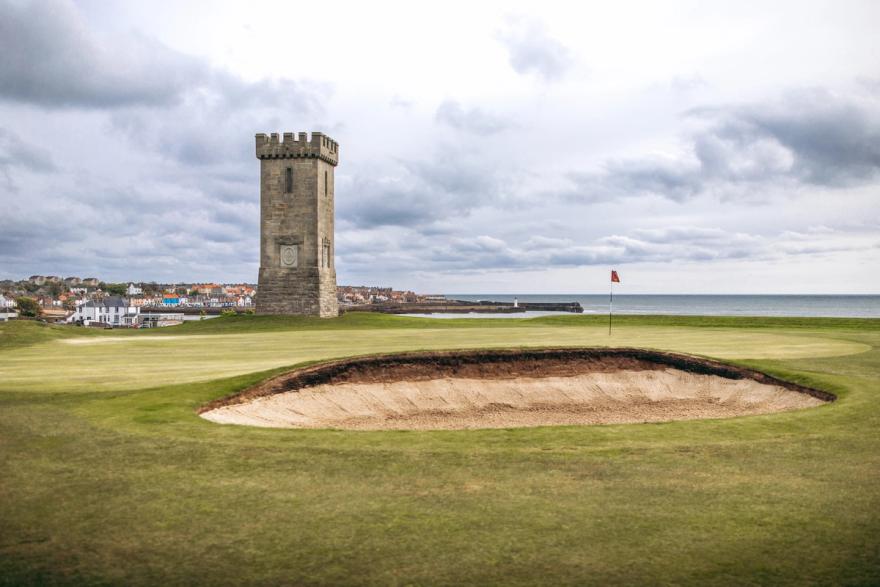
2nd Green at Anstruther Golf Club. Photograph by Jim Hartsell
Golf is supposed to be fun. This concept has been lost for a long period of time, especially in the United States. For many years, courses were designed and promoted based on their length and difficulty. As part of this trend, courses that did not fit the standard of 7000 plus yards, 18 holes and par 72 were relegated to the semi-derogatory category of “short courses” or “holiday golf.” With the increasing popularity of nine hole courses like Sweetens Cove Golf Club in South Pittsburg, Tennessee and Winter Park Golf Club in Florida, Americans are slowly starting to realize that the Scots had it right all along.
The somewhat arrogant implication by certain golf experts has often been that these non-standard, “quirky” layouts are not serious golf, or should even be played by serious golfers. If a golfer is going to the trouble of crossing an ocean to play, they must surely test themselves at championship venues like Carnoustie, Troon and Turnberry. The day we played Anstruther, I hit a full driver into the 7th, an uphill 145 yard par 3. This seems like serious golf to me. Each successive hole asked a new and exciting question. We could not wait to go back around.
Fun and challenging courses can come in all formats and lengths. Par really doesn’t matter at Anstruther Golf Club, other than as a vague frame of reference. The concept of playing golf simply for the sheer enjoyment of it has never been lost in Scotland, a country that has the best collection of fun, “quirky” layouts in the entire world. Seemingly every small town you pass through has a golf course that serves as the social center of the community.
We arrived at Anstruther Golf Club around 8:30 am to find the clubhouse was locked, except for one door leading into a small vestibule outside of the locker rooms. Nobody was around, except for a local member about to go out alone. Perhaps sensing my confusion, he said, “Normally you pay in the bar, but they don’t get here until 10. Just put your money in the wee honesty box and go play.” What followed was a collection of five par 3’s and four par 4’s (Par 31) that almost defy description. Every hole was memorable and fun. How often can you recall every hole in detail after only playing a course once? Anstruther is that kind of place. We played all day. When we came in for lunch following our first 18 holes, I asked the helpful bar manager if I should give her additional money for a day ticket. She looked a bit confused and asked, “You want to play all day? Oh I don’t know, just give me 10 pounds to cover the both of you.” When I told her how much we loved the golf course, she immediately handed each of us an Anstruther ball marker. It would be difficult to find more generous and welcoming people than the Scots.
Yardage is also completely irrelevant when you are playing by the ocean in Scotland. The downhill 238 yard par 3 9th at Anstruther, playing right back into the lovely fishing village, required anything from a 5 iron to driver and full 8 iron during our 45 holes that day. We did not want to leave the place. Matt Maclachlan, the friendly General Manager, met us in the clubhouse bar after we finally decided to stop playing. “I’ve been following your day on twitter, he said. I’m so pleased you’ve enjoyed the course.” We discussed strategy on the various holes with Matt and some older members who were in the bar for an evening pint. When I asked one elderly gentleman how to play the tee shot on “The Rockies” - a blind 238 yard par three 5th played over a cliff and down to the rocky beach located precipitously below - he shook his head slowly and said, “Hit it and pray.” At Anstruther, there is a sincere appreciation for the game and a genuine interest in how visitors feel about the course. A day playing golf at Anstruther, with the sun out and the sparkling ocean in full view, is a perfect day.
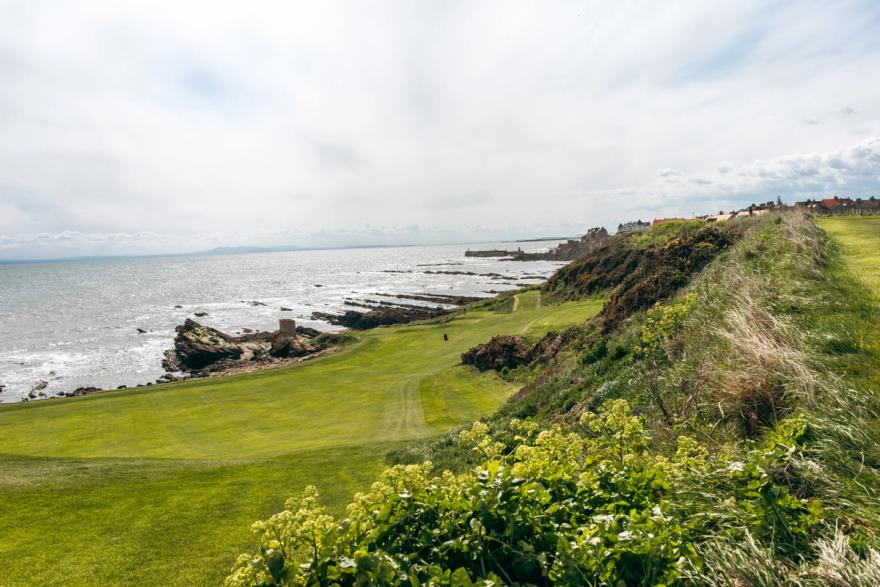
5th Hole at Anstruther Golf Club. Photograph by Jim Hartsell
After visiting the Golf House Club at Elie, we reluctantly left the Kingdom of Fife and headed north. Following rounds at Cruden Bay and Fraserburgh, we reached Cullen Links. Cullen, which lies about 3 hours north of St. Andrews over the Firth of Tay and up the coast, is 18 holes. That is where the similarities to a standard 18 hole golf course end. It is a par 63. It is 4800 yards. There is only one par 5. Several shots are played over and around massive red rock formations that look like a scene from Frank Herbert’s Dune.
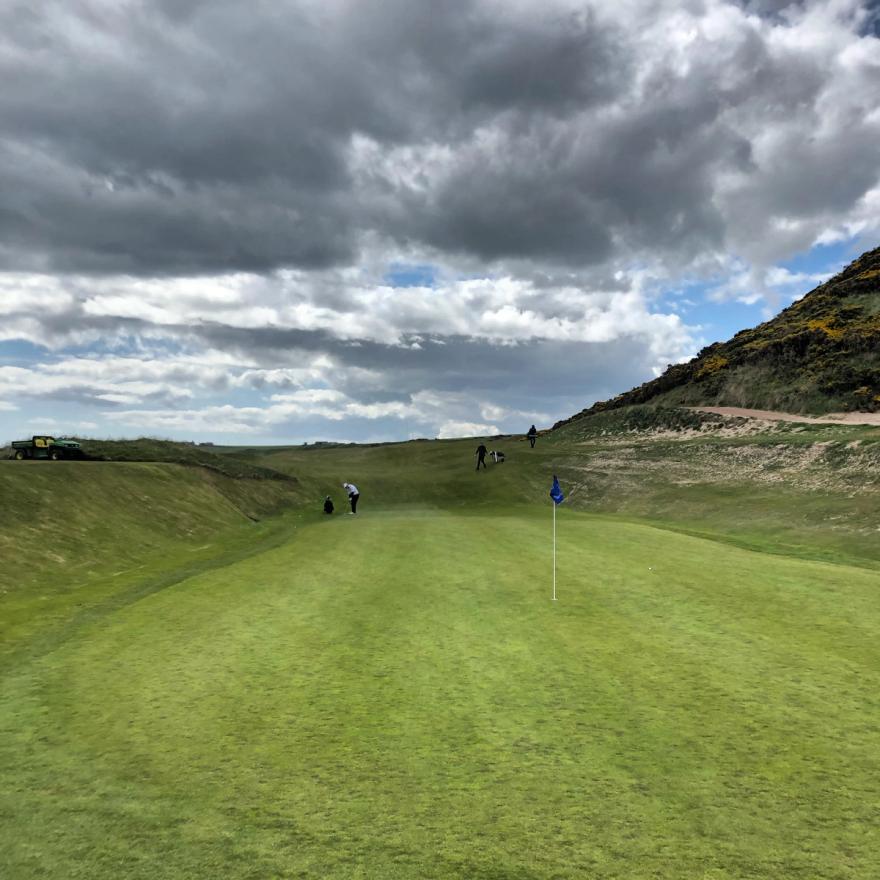
Cruden Bay. Photograph by Jim Hartsell
Many golfers in the USA were first introduced to Cullen through the popular YouTube travel series Tourist Sauce by the golf merchandise and multi-media group No Laying Up. In the video segment, the NLU boys are seen playing with two time club champion and lifetime Cullen member, George Clark. We were able to arrange to play Cullen with George and he greeted us warmly in the clubhouse bar upon our arrival. After a nice lunch - and requisite pint of Tennent’s - we paid the modest green fee at the bar and went out to play.
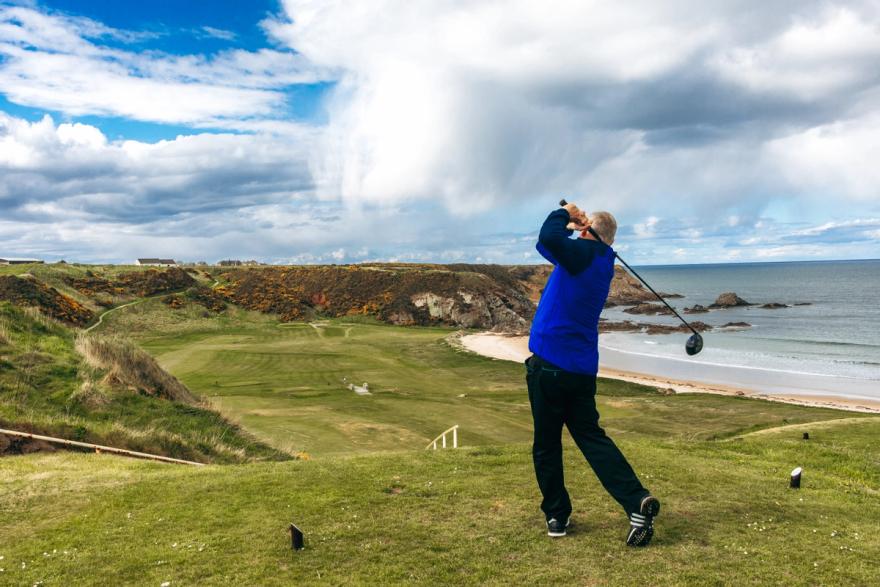
Cullen Golf Club. Photograph by Jim Hartsell
With a short and efficient Scottish swing, George was a joy to play with. He gave us the grand tour of the ethereal Cullen Links. You could sense his pride in the course and excitement in the fact that it was starting to receive some notice in the golf world due to the visit from NLU. “I had a man stop me on the street in Aberdeen and shake my hand. He said, “You’re George from Cullen in the No Laying Up video!” It’s all been amazing. Our visitor play is up 30% just now.” He hopes the time has come for more acceptance in the game for courses like Cullen. “I live in Aberdeen now and I’m a member at Murcar, but I drive up here as much as possible to play.” You cannot play Cullen Links without a smile on your face. You might even shoot around par. You may not lose any golf balls. You will play fast. You will hit shots on the ground and over towering red rock obelisks. These are all good things.
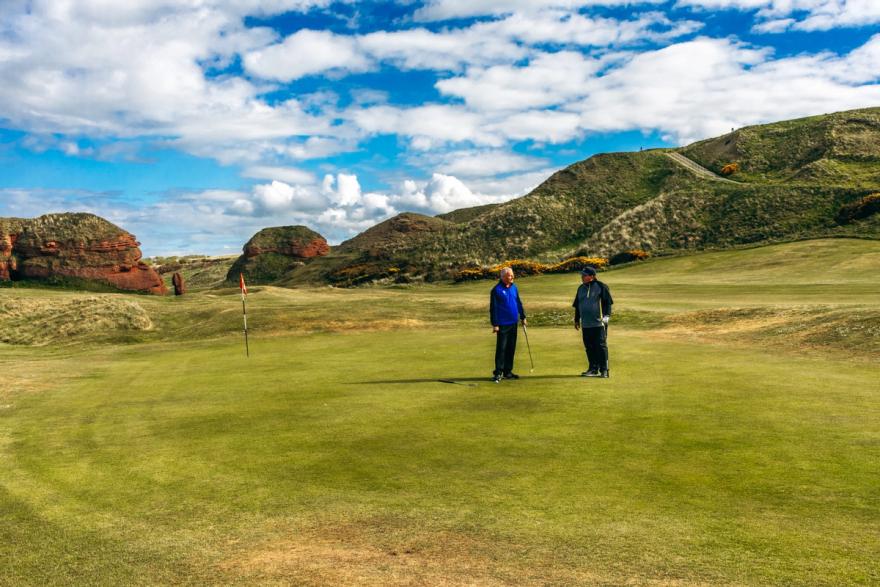
Jim with Mr. George Clark at Cullen. Photograph by Jim Hartsell
After saying goodbye to George in the small Cullen car park, we were off to Covesea Links, about a 45 minute drive up the coast on the A96. Despite having already played 36 holes, we reckoned there was just enough time to get in 9 more holes before dark. We didn’t know much at all about Covesea, save for a few random pictures on Instagram and twitter. Even most of the Scots that I had talked to on our trip were not familiar with it. Despite our growing weariness, the lure and excitement of another 9 relatively unknown holes of Scottish seaside golf was too strong to pass up.
Following a ¾ mile drive down a single lane gravel track off the B9040 just past Lossiemouth, we entered the hidden world of Covesea. Angela Burnett came out of her trailer to greet us - the lone car on site. She and her husband Andy, the course designer and builder, are the owners of Covesea and live on the property. The course is obviously a labor of love for both of them. She told us she was very happy that we had made it to their wee course and mentioned that the American author Tom Coyne had visited previously. Concerned that we might not be able to find a place to eat dinner after our round, she made us reservations at a nearby local restaurant in Lossiemouth. We were treated to these types of small kindnesses time and again at places like Covesea.
The course itself is nine holes, 2,000 yards, with a par of 31. There are five par 3’s and four par 4’s. I got the impression that very little, if any, earth was moved to create these natural golf holes in this almost mystical, secret cove. We played when the sun was low and the course was bathed in a golden hue, accentuating the vibrant yellow blooms on the gorse. The uphill par three 5th and the short downhill par three 9th are brilliant. It is a relatively new course and not that well known, but one of the most beautiful settings for golf that can be imagined. We left feeling that we had experienced something really special and unique in the world of golf. Our dinner reservation in Lossiemouth ended a perfect day.
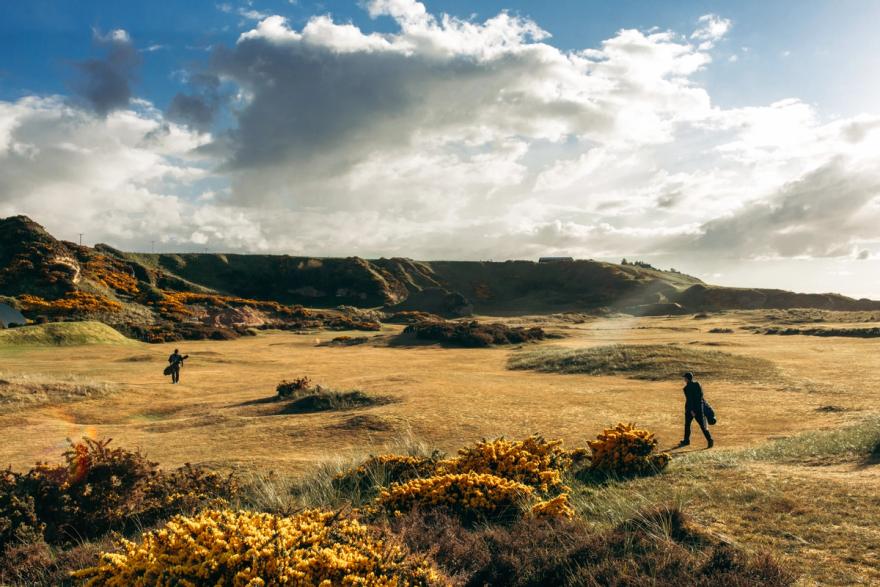
2nd Fairway at Covesea Golf Links. Photograph by Jim Hartsell
After a beautiful and leisurely drive through the Scottish Highlands, we based the remainder of our trip in Kintyre and Arran, a veritable treasure trove of hidden and generally unknown (to Americans) golf courses. I had heard of Carradale Golf Club, but had never made the sometimes harrowing drive from Campbeltown up the B842 to this beautiful spot on the headlands overlooking Kilbrannan Sound and the Isle of Arran. We were greeted warmly in the small car park next to the tidy clubhouse by the club secretary Rhona Elder. “We are so pleased you made it to Carradale,” she said formally. “The committee has met and decided that you can play off the medal tees today. We want you to get the full experience of the course. Robert, our Greenskeeper, is out there as well, if you have any questions.” We put our green fee in the honesty box and walked out to the first tee, all alone in the stunningly beautiful landscape of the Kintyre Peninsula. On a clear Tuesday morning, we had the course to ourselves, other than several people walking their dogs.
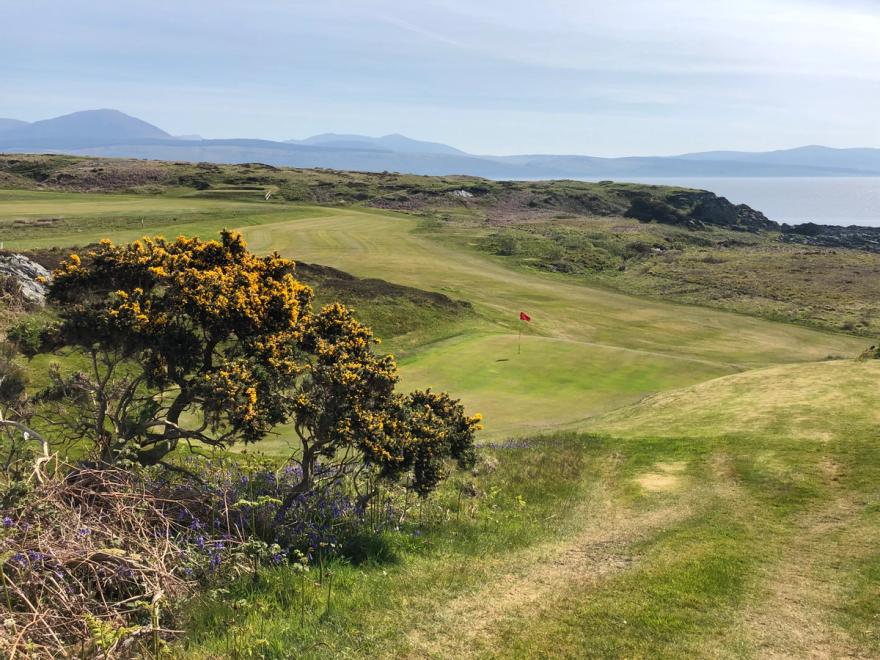
6th Hole at Carradale. Photograph by Jim Hartsell
The blind uphill par three 1st lets you know immediately that this is pure, thrilling Scottish golf. Robert Strang, the Greenskeeper, met us at the top of the hill by the 1st green. I asked him if the course was in good condition at the moment. “Oh aye, aye. It is indeed. Ken Brown was out here last week and was very complimentary.” I can confirm that the former European Ryder Cupper was correct in his positive assessment of the links. The downhill second, with an approach shot played over an old stone wall, was a particular standout. When we reached the 4th, we understood why Rhona and the Committee had given us the wholly undeserved honor of playing off the medal tees. The 4th tee at Carradale commands a view of Scotland that may be unmatched in the world of golf. We stood in awed silence for 5 minutes, taking in the entire world of this underrated links, before hitting our tee shots. Carradale is a sheer joy to play.
We were based in the lovely town of Campbeltown - home of the legendary Springbank Distillery - for this part of the journey. Machrihanish Golf Club - 10 minutes from town on the B843 - is widely acknowledged as one of the greatest courses in the world, and rightfully so. I first played it in 1994 when it was virtually unknown to American golfers. It has remained the standard by which I judge all other true links courses. However, the ultimate revelation of our journey lay not at legendary Machrihanish, but in the penultimate round of our trip. Located some 15 minutes south of Campbeltown on the B842 in the village of Southend, Dunaverty Golf Club is 4799 yards with a par of 66. There is 1 par 5 on the course. The western side of the course is leased from a local farmer, who has grazing rights. I had played the course on previous trips as a much younger man, including a wonderful day in 1994 with my Dad. Yet somehow Dunaverty had not remained as prominent in my memories as Machrihanish.

Machrihanish Dunes. Photograph by Jim Hartsell
The magic of golf twitter had allowed us to join up at Southend with Robbie Wilson, a Machrihanish member and fine local golfer from Lochgilpead who plays the course frequently. Robbie looks after historical monuments in Kintyre and Argyll for Historic Environment Scotland, a job which fascinated me as an Architect. We had much to discuss as we walked this mighty golfing ground with our new friend. Scots play golf with remarkable and admirable speed, but we never felt rushed as Robbie gave us the grand tour of the world of Dunaverty. He pointed out the correct line on every shot and offered advice on strategy that we would have never known to employ. We laughed out loud at the sheer brilliance of hole after hole. Just when we thought we must’ve seen the unfathomable heights of the course, the next hole would somehow top it.
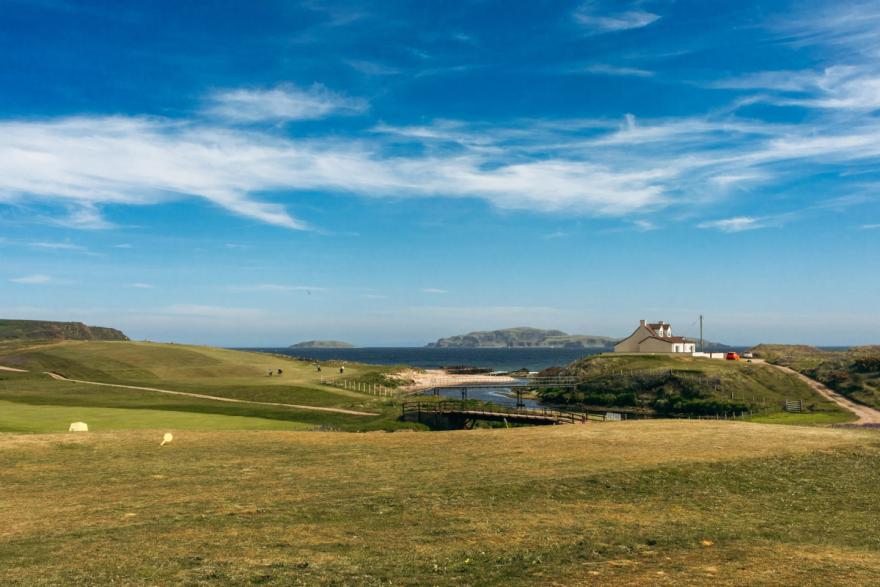
Dunaverty Golf Club. Photograph by Jim Hartsell
I cannot pick a favorite hole at Dunaverty. I love all of them. The punchbowl par three 4th, the thrilling par four 5th, alongside and above Brunerican Beach, the uphill par four 9th over a ridge and down to yet another fantastical punchbowl green. The downhill par four 11th, with all the mighty world of Dunaverty laid out below you. The brilliant par five 13th, with a blind second to a wonderfully sited green, played alongside a 5,000 year old standing stone. The unique 17th with the brilliant 2nd shot over the Coniegien Burn and back onto Machribeg Farm. All of these are great golf holes. The local cows, sensing our approach, joined us in the 18th fairway for a perfect finish on a perfect golf course. The great British golf writer Bernard Darwin wrote about the feeling of “pleasurable excitement” you have when playing a great links course. Dunaverty gives you much more than just that feeling. It is a fantasy world of true links golf.
After one last day in Campbeltown and an incredible tour of the Springbank Distillery, we left the Ardshiel Hotel early to catch the first ferry to Arran, from Claonaig to Lochranza. We were to cross the Kilbrannan Sound, which we had viewed previously from the unforgettable 4th tee at Carradale. Our trip to the fringes of Scottish golf could only end with 2 rounds at the mythical Shiskine Golf Club in Blackwaterfoot. The ferry foreman, seeing our golf caps, asked quickly, “Where are you going to play? Arran has more brilliant wee courses than any place in Scotland.”
When we mentioned the entire day was planned for Shiskine, he said, “Aye, indeed. You cannot go wrong there. Great golf course. If you have time, try to play Corrie on the other side of the island. You must play there too. 9 holes. Absolute stunner of a course.” Our gears started turning and we called Caledonian MacBrayne to change our ferry reservation to the last one of the day. Maybe we could play Shiskine twice, and somehow get in 9 at Corrie Golf Club, before the 7:20 ferry departed for the mainland.
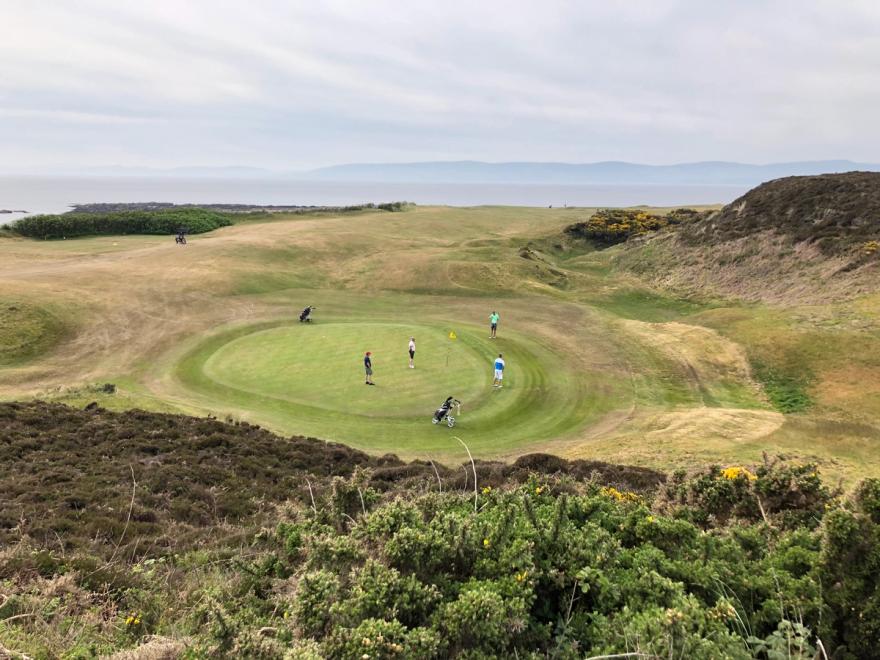
6th at Shiskine. Photograph by Jim Hartsell
How do you begin to explain heavenly Shiskine? It has 12 holes, a front six and a back six, with a par 21-21-42. There is a single par five, four par fours and seven par threes. It may be the perfect golf course. Every hole is memorable. The par three 3rd and 4th holes are brilliant and unmatched in the game. The par four 6th, the Shore Hole, is a potentially drivable hole to the most perfectly sited green I have ever seen. What you see in front of you almost does not seem real, as if you are in some wild fever dream of golf. The greens are fantastically sited in natural dells or on precarious plateaus. We lost 1 ball between us in 24 holes. Yet to consider this mere “holiday golf” is to do a disservice to the course. You must think about the correct line for your tee shots and the proper way to play your approach shots. The correct shot may be 40 yards off line from what appears before you. As you walk off the 12th hole, you immediately want to go back and start again.

7th at Shiskine. Photograph by Jim Hartsell
We ate lunch in the lovely clubhouse and quickly headed back out to play another round. Checking in with Head Professional Douglas Bell, in his well-stocked golf shop by the first tee, (complete with Isle of Arran ice cream) we began to tell him how much we loved the course. “Aye, it’s a nice spot indeed,” he said simply. Scots are masters of understatement. I told him every hole was great and he nodded his head in agreement, “Aye, they are.” When Jake informed him of our plan to try to quickly play 12 more at Shiskine and then rush over to Corrie to play before catching the last ferry to Ardrossan, his mood suddenly grew serious. “Corrie is a fine course and not to be missed, but I urge you to take your time and enjoy your last 12 holes here at Shiskine,” he said while gesturing out to the links. “You don’t want to rush this. Look at what is out there in front of you. Enjoy the walk and remember your time here together.”
Heeding Mr. Bell’s wise advice, we savored each perfect hole that sunny afternoon at Shiskine Golf and Tennis Club. Corrie Golf Club would have to wait for another trip. The true soul of the game of golf resides in places like Anstruther, Cullen, Covesea, Carradale, Dunaverty and Shiskine. To dismiss these courses as mere “holiday golf” is a mistake that should not be made. Show up, put your money in the honesty box, and try to stop smiling for the next 3 hours. You might even take a trip where the green fees are not a major expense. There is a lesson to be learned from the Scottish game. Golf is supposed to be fun.